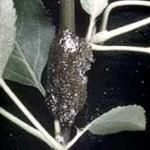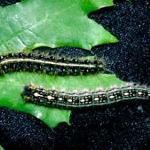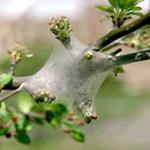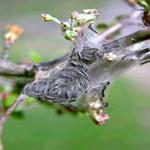Eastern Tent Caterpillar
Order: Lepidoptera
Family: Lasiocampidae
Malacosoma americanum
Overview
The eastern tent caterpillar is a native insect common to the eastern part of the United States. Eastern tent caterpillar larvae are most frequently found feeding on the leaves of ornamental and wild cherry, crabapple, and apple; however, many other host plants exist. Defoliation and cosmetic damage to tree leaves and branches are sometimes quite evident. At times, these insects can cause significant defoliation, particularly during an outbreak when the population naturally peaks every 8-10 years. However, this native insect has multitudes of natural enemies that typically keep them below damaging numbers. Often, chemical management of this insect is not necessary.
Host Plants
Eastern tent caterpillars primarily feed on ornamental and wild cherry (Prunus spp.), crabapple (Malus spp.), and apple (Malus spp.). Additional host plants include but are not limited to: ash (Fraxinus spp.), birch (Betula spp.), blackgum (Nyssa sylvatica), cherry (Prunus spp.), maple (Acer spp.), oak (Quercus spp.), peach (Prunus persica), plum (Prunus domestica), poplar (Populus spp.), willow (Salix spp.), and witch-hazel (Hamamelis spp.). When caterpillars are abundant, they can completely defoliate the tree, creating unsightly webbing in the branches as they feed.
Identification/Life Cycle
Eastern tent caterpillars are perhaps best known for the collective “tents” they create with webbing between the branches of their host plants. These tents occur in the crotches and forks of branches in the spring and early summer, and should not be confused with fall webworm tents, which occur at branch tips in the late summer and fall.
There is one generation of the eastern tent caterpillar per year. The insects overwinter as egg masses on twigs, and they hatch in April. Eggs are laid in masses of 150-350. These masses encircle small twigs, have rounded edges, and are a dark gray with a shiny coating. Larvae hatch from these egg masses in the spring, well timed with the opening of wild cherry leaves. After a short period of feeding, larvae begin to weave their tent. Larvae work in groups, gathering at branch crotches and begin to build a web which will grow in size as the caterpillars continue to feed. Successive layers are added to the tent as the larvae develop.
On warm, sunny days, the caterpillars will emerge from the web, which is used mostly for thermal protection on cold spring nights, and feed on the expanding foliage. Often, there will only be one tent per plant and not all similar plants within close proximity will be affected.
Fully grown caterpillars are hairy, basically black in color with a long white line down the back with smaller yellow lines and blue spots. At maturity, the larvae are 1 1/2" - 2" long. They resemble the larvae of the forest tent caterpillar, which has white "keyhole" or "penguin" markings down the length of its back, and not the white stripe. This insect is often confused with the forest tent caterpillar (Malacosoma disstria) which does not construct a web/tent.
Once mature, the caterpillars disband from the web and seek appropriate shelter to pupate, spinning a white cocoon around themselves. Pupation may occur on host plants, fences, and other objects. This occurs early in the summer, and the eastern tent caterpillars emerge as adults soon after in late-June, early-July and are reddish brown with white stripes on their forewings. They are rarely recognized due to their innocuous appearance and short life span.
After mating, the female will lay a batch of eggs, about one inch long, around the stems of 2-3 year old branches (primarily). These egg masses are covered with a shiny black material and house upwards of 350 eggs. These eggs will over-winter and hatch soon after budbreak on the host plant. The caterpillar stage lasts about 5-6 weeks.
Damage
Eastern tent caterpillars occasionally outbreak and defoliate deciduous forest and ornamental trees. While this can concern land- and homeowners, healthy trees can withstand the defoliation and should recover without intervention. However, repeated heavy defoliation or stress from additional factors can compromise tree or shrub health.
Damage can range from light to heavy defoliation depending on the size of the tree attacked and the number of webs per tree. If the damage to the tree is minimal and the tree is otherwise healthy, they can typically continue to produce healthy foliage the following year.
Management Strategies:
Mechanical management, such as removing eastern tent caterpillar nests when they are still small, can be a suitable option to manage this insect in ornamental trees and shrubs where they can safely be reached. In some cases, damaging the tents with a pole can cause the caterpillars to fall to the ground. This may allow natural enemies such as predators and parasitoids access to the caterpillars. Insecticides are not typically necessary to manage the eastern tent caterpillar, and may be difficult to apply as caterpillars spend much of their time protected in their tents.
Cultural/Mechanical Management:
Eastern tent caterpillars may be mechanically managed in a couple of ways. If egg masses are seen prior to springtime egg hatch, those can be pruned from susceptible host plants and removed. Damage on small trees can be reduced by locating and removing egg masses during the winter.
Following egg hatch, tiny larvae and their still-small nests can also be pruned from the host plant and removed. Nests containing caterpillars can be removed at any point during the growing season, as long as they can safely be reached. Some land managers also use high pressure water sprays to disrupt eastern tent caterpillar nests. Never set fire to eastern tent caterpillar nests. Not only does this practice disregard fire safety, but it can cause more damage to the host plant than the caterpillars themselves.
Young, exposed larvae (caterpillars) may be susceptible to predation by birds. Older caterpillars are fed upon less because they have hairs on their bodies that deter birds from feeding on them.
Lastly, a cultural solution to the eastern tent caterpillar is to learn to live with these native insects. They are a natural part of our forest ecosystems, and hosts of many other organisms. They rarely cause tree or shrub mortality, although can create unsightly webbing and cause some defoliation that may reduce host plant vigor. Many trees can grow new leaves to replace the defoliated ones.
Biological Control/Natural Enemies:
Parasites of this insect are usually effective. There are occasional outbreaks (every 8-10 years) of eastern tent caterpillars and annual spot infestations in landscapes. Several natural enemies of the eastern tent caterpillar exist, including birds, small mammals, insect predators, and parasitic wasps.
Natural enemies (including insects) of the eastern tent caterpillar play an important role in reducing their numbers in most years. Eastern tent caterpillars are frequently parasitized by various tiny braconid, ichneumonid, eulophid and other wasps (Choate and Rieske, 2005).
Certain diseases, bacteria, and fungi such as the soil dwelling bacterium Bacillus thuringiensis, also help to regulate their populations. Eastern tent caterpillars can be infected with Nosema disstriae (microsporidians) as well as a nuclear polyhedrosis virus (Choate and Rieske, 2005; Nordin, 1974).
Chemical Management:
Larvae leave webs on warm spring days to feed; foliar applications are said to work best at this time. Otherwise, caterpillars may be protected from contact insecticides when found inside their webs.
Many active ingredients are labeled for use against eastern tent caterpillars in Massachusetts, including but not limited to: abamectin (NL), acephate (NL), azadirachtin (NL), Bacillus thuringiensis subsp. kurstaki (NL), bifenthrin (NL), carbaryl (L), chlorantraniliprole (NL), Chromobacterium subtsugae (NL), cyfluthrin (NL), deltamethrin (L), emamectin benzoate (L), gamma-cyhalothrin (L), indoxacarb (L), insecticidal soap (NL), lambda-cyhalothrin (L), malathion (L), methoxyfenozide (NL), permethrin (L), pyrethrins (L), pyrethrins + piperonyl butoxide (L), spinetoram+sulfoxaflor (N), spinosad (NL), tau-fluvalinate (NL), tebufenozide (NL), and zeta-cypermethrin (L). Contact a Massachusetts licensed pesticide applicator for assistance.
Read and follow all label instructions for safety and proper use. If this information contradicts language on the label, follow the most up-to-date instructions on the product label. Always confirm that the site you wish to treat and the pest you wish to manage are on the label before using any pesticide. Active ingredients labeled "L" indicate some products containing the active ingredient are labeled for landscape uses on trees or shrubs. Active ingredients labeled "N" indicate some products containing the active ingredient are labeled for use in nurseries. Always confirm allowable uses on product labels. This active ingredient list is based on what was registered for use in Massachusetts at the time of publication. This information changes rapidly and may not be up to date. If you are viewing this information from another state, check with your local Extension Service and State Pesticide Program for local uses and regulations.
See the Professional Insect & Mite Management Guide for Woody Plants for more information about eastern tent caterpillar management on trees and shrubs.
References
NC State Extension: Eastern Tent Caterpillars
PennState Extension: Eastern Tent Caterpillar
University of New Hampshire Extension: Fall Webworm and Eastern Tent Caterpillar Fact Sheet






